I just discovered a really smart ordinary guy… on Amazon!
Not that there weren’t any other intelligent people with a wide range of interests among the 7.9bn on this planet, but most such individuals are anonymous, unknown outside a small circle. Not being narcissistic like all the retards, and not having a YouTube channel or a Facebook account, their intelligence and common sense are only useful to them.
I used the past participle “discovered” and not a verb that would suggest further knowledge, because I don’t really know much about this person other than what his Amazon account publicly states:
Gareth Greenwood, from Wales, UK, having posted 294 reviews.
And I have read a good deal of his reviews!

What I discovered is almost a polymath, and a person with which I reckon I could agree in more than 75% of the cases, and that’s something!
Based on what I read, I believe Gareth is a (relatively recently retired) software developer at about 70 (yes, I believe he’s this old!), with a solid education, and with curiosities and expertise in several fields. Let’s briefly summarize what it reviewed on Amazon UK:
- Scientific calculators, but also simpler pocket and desk school and financial calculators (more on that, later).
- Programming/software developing books on: Tcl/Tk, JS, XSLT, XML, Rust, GUI/UX/HCI, X Window with Xt and OSF/Motif, Ada, Pascal, C, VB, wxPython (“This confirmed me in my view that, with exceptions you could count on a badly mutilated hand, OO languages are designed by the retarded for use by the brain-damaged.”), compilers, GDB, embedded C, Petri nets, PLCs, software testing.
- Books and textbooks on mathematics (mostly differential and integral calculus, finite mathematics, numerical analysis, numerical methods), probabilities and statistics books, with a stress on the old-school Russian books (“What communism did badly it did atrociously. What it did well, it did brilliantly. The achievements of Soviet mathematicians were part of that brilliance.”) from the 1960s and 1970s (Piskunov, Gnedenko), but also by Édouard Goursat, and George Pólya (“How To Solve It” dates from 1945), then graphs and nomograms; and how about Gauss’s “Disquisitiones Arithmeticae”?
- Philosophy books (Kierkegaard, Locke, Wittgenstein, J.S. Mill, Scruton, Hospers, etc.).
- Books on economics (Fischer and Dornbusch, Steve Keen, Nicholas Barr, etc., but also F. A. Hayek, Karl Marx).
- Classical books (Ovid, Plato, Homer), books on history (of Britain, of France, of the US), chemistry, physics, automobile repair books (for his Skoda), electric motors, hydraulics and pneumatics, astronomy, ethics, classification, then some popular names such as Taleb, Levitt, Landsburg, and Harford.
- French monolingual dictionaries, French-English dictionaries and French grammars (he needs to translate from French).
- German-English dictionaries, and German dictionaries and grammars.
- English style manuals, thesauri, and related helper tools for writers.
- Art albums (Turner, Kandinsky, Dali), occasionally music CDs (Scott Joplin).
- Crime mysteries (Poirot, Frost).
- Hardware meant to revive older laptops/PCs and make them run Puppy Linux, Lubuntu, even Win7.
Quite comprehensive, I’d say. Once again, I didn’t only browse them, I’ve actually read about a third of the reviews!
The sad thing is that most of his insights are lost on today’s stupid populace. Not only the typical software developer, especially if under 40, is on the moronic side, but mostly everyone is dumber and dumber. The newer generations are walking zombies, shit stupid and all.

To end with something more palatable to the public, have some bits of his obsession with calculators. I gather he’s a bit of a fan (but not a fanboy!) of TI’s and HP’s, and a hater of the Japanese brands.
I can understand this at least in part, especially as CASIO manufactures dozens of models of overpriced scientific calculators with small differences between them, for the mere reason that they’re number one in France and Germany (TI being on the 2nd place in both countries), and they lobbied the Ministries of Education in many countries (in Germany, particularly in the Länder of Bavaria and Baden-Württemberg) so that students in gymnasiums, colleges, high schools, etc. are required to purchase and use such calculators in class! That’s big bucks for CASIO and TI (SHARP can’t compete with them, and they only “conquered” South Africa). Most such scientific calculators are used in class and even in exams (with the programming mode disabled, if they’re programmable; in Germany, other advanced functions need not exist for a calculator used during an examination, so e.g. TI-30X Plus is accepted, but TI-30X Pro isn’t); how were we able to live in the past without calculators in class?! Today, scientific calculators are used in schools for stupid assignments where teenagers solve matrix equations and calculate various statistical parameters without ever understanding what’s that good for, or, in lower grades, for stupid arithmetic with fractions! This is exactly how a society makes idiots using the public education system, but again, this is how money is made too. Graphing calculators cost much more than GeoGebra, as the latter is free! By the way, CASIO has special models for Germany: fx-82DE Plus (a modified fx-82ES Plus), fx-85DE Plus (based on f-85GT Plus), fx-991DE X (with 696 functions, whereas fx-991EX only has 552 functions!), fx-87DE X (a dumber edition of fx-991DE X, with 593 functions), etc., and special editions for France too, such as the unique fx-92+ Spéciale Collège that adds the most retarded programming language on Earth, something similar to Scratch, but with keywords in French!
To be fair, CASIO and TI have also introduced Python capabilities in some models (starting in France for both companies, I guess), but here too it’s only about lobbying, corruption, and selling underpowered, overpriced crap. Python is anything but usable on the TI-84 Plus CE, which features a 15 MHz Z80 CPU, 3 MB of storage, and 154 KB of RAM! Any Android tablet is infinitely more powerful, and also cheaper. CASIO’s Graph35+E II Python Edition is marginally better with SH3 or SH4 processors at 29.5 MHz, but MicroPython is a joke compared to the “real” Python. Finally, the fact that TI removed the ASM/C Programming from TI-83 Premium CE (first in France, later in the States), citing “security issues” (“At TI, we are constantly working on ways to improve our products to give students more opportunities to learn, explore and investigate math and science. After careful consideration, we made the decision to remove ASM functionality in our latest OS update to prioritize learning and minimize any security risks.”), only proves that their business revolves around the forced sales established by some Governments for schools, and they don’t care about the “real public”: university students, engineers, chemists, scientists at large.
Back to our guy, I found it funny to read his opinions, as they complement my former app-mania (see Nostalgia & Fun With Calculators), of which I’m mostly cured (I prefer physical calculators, because nothing can replace the tactile feeling of pressing a button; for a scientific calculator app, I’d still go for the Scientific Calculator by Philip Stephens though). Gareth is extremely straightforward and strongly worded: il ne mâche pas ses mots!
Sharp EL-W506T is Horribly inaccurate at numerical integration:
Gets numerical integration wrong. Get it to integrate sin(2*pi/X) from 0.01 to 0.1 and the answer has a relative error close to 100%. IMO this makes it unsuitable even for school use. Comparable Canon, Casio, and TI devices are better IMO.
Sharp EL-W506B is Mass market manure!
Yet another awful Japanese calculator. Seemingly the Shrap EL-W506 is pitched to compete with the Crassio fx-991ES PLUS, which it does by being just as full of illogical and pernicious features. Asking school students to use these is IMO tantamount to child abuse. The Japanese just don’t get it that to make a calculator that allows you to enter formulae as you write them and display results as they would be printed, you need a general-purpose chip inside the device and NOT a calculator ASIC.
Also the numerical integration function produces results with a nearly 100% relative error in one test I’ve carried out. Unfit for purpose IMO.
Don’t buy this dire piece of dung. Burn any that you find. Do your kids a favour and get them the best calculator from HP or TI that is allowed in exams.
Sharp EL-531W too is Mass-market manure – get a professional level calculator from HP or TI:
Useless for serious professional purposes. Not programmable. Formula entry system just as screwed-up as equivalent Casio models, still riddled with absurdities. Also some base-conversion functions appear incorrectly implemented. Making school kids use these is a form of child abuse. If you’ve been told to get it for school, then you have my sympathy. Otherwise get the best calculator that is currently allowed in exams, namely the TI82-PLUS. Today’s Japanese calculators are simply rubbish.
Here are some examples of what this piece of junk does:
Key in: 2+13% and the display shows 2+13% and the numerical answer 2.26, showing that =_% is a compound operator. Now press = and the display shows 2+13= and the numerical answer 15. Conclusion: The trailing = removes the % operator and recalculates as if only = had been entered. This is atrocious HMI design.
Set it into hex mode by 2ndF ->HEX and enter 5+ALPHA A = and you get the answer 5. To get the correct answer F, you should have entered 5+A=, i.e. you don’t need the ALPHA key when in hex mode but if you do use it you get the contents of memory A (in this example 0) and not the hex value A. Only a small difference in the dot matrix font distinguishes the A in each case. Yet again atrocious HMI design. If they must do this, then it would be better to have the hex digit denoted in the normal dot-matrix font and the memory access denoted by the slightly emboldened font.
In degree mode enter sin(30)x2= and you get the answer 1. Enter sin(30) followed by the squaring button and the answer is 0. This shows that the squaring operator has higher precedence than sine function application. This is just plain wrong.
These imbecilities all arise out of poorly thought out interactions between the unnecessary number of implicit modes and the basic keystroke input language. Are the Japanese designers incapable of understanding this? It’s not difficult, or at least it’s not difficult when your native language has a small alphabet instead of ideograms. Sharp would do much better by letting a team of experienced European UI designers and language implementors rewrite the software from scratch. As for this dire device, they should take those responsible at Sharp’s Nara research centre, give them new concrete shoes and take them for a swim in the middle of the Pacific. Not, of course, that I hold extreme views in these matters.
Casio FX-991 ES PLUS is An apotheosis of execrable design:
Frankly these things are toys. The algebraic formula entry system is ridden with anomalies that will infuriate competent mathematicians. What’s more, they don’t preserve keyed-in formulae when you switch them off – which is useless for professional purposes. Serious calculator users opt for the real deal, i.e. top-end models from TI and HP. Casio, and for that matter any other Japanese calculator brands are, IMO, mass-market crap.
The hyped “Visually Perfect Algebraic Method” is far from perfect. Try calculating sine-squared x + cos-squared x. It certainly doesn’t accept that how it’s normally written/typeset and it enforces that limitation by adding an open bracket after the function designator. I infer that it has been programmed by geeks who are not particularly mathematically literate.
The equation solver is junk. It doesn’t let you specify limits between which a root is to be sought while at the same time trying to find it using Newton’s method, which has good local but abysmal global convergence. Getting it to solve e^(-x) = sin(1/x) demonstrates its limitations. This teaches kids not to do basic function investigation in numerical work but simply to press the buttons.
While the random number generator facilities are nicely packaged, the user manual gives no details whence the quality of the pseudorandom sequence may be assessed – quite useless for professional work.
The table mode is a decent capability but there is absolutely no need to have a separate mode for complex calculations, so why introduce such a gratuitous inelegance? Similarly there is no need for a separate mode when using number bases other than 10. Also, why have separate matrix and vector modes when a single mode will do both? Heavily moded user interfaces are generally deprecated in computer GUIs, so why revert to bad UI practice in a calculator aimed at schoolkids? This may, of course, be a symptom of poor understanding of good user interface design in Japan. They are years behind the leading edge that you see in Scandinavia. It’s yet another own-goal from Crassio. (And Shrap is not much better.)
… yet we foist this cr@p on our children! These things should be banned from schools.
If my granddaughter can cope with it, I’ll be teaching her how to use a RPN calculator instead of this Japanese techno-dropping.
Casio FX-991EX is better, Functionally capable but poor visual design:
As you’d expect, Casio’s flagship school-level calculator packs more functionality than its rivals. On the other hand, there are things that Casio has cocked up in this device:
1. It can be difficult to see items on the hi-res screen. Various lower resolution competing devices are actually easier to read
2. The texture pattern on the keyboard makes the printed symbols unnecessarily hard to make out
3. Complex arithmetic is still too limited for many professional uses. It is hardly impressive that when in complex mode and asked to compute e^(πi)+1, it proclaims “Math error”. There’s nothing at all erroneous about it. Indeed, by Euler’s formula, the result is zero.
4. Additive result precision is 12 decimal digits, while multiplicative result precision appears to be 15 digits. (The competing Canon F-789SGA gives 16 and 20 digits respectively.)
5. The spreadsheet function is very inconvenient to use on so small a screen.
IMO the Canon F-789SGA, though still unable to evaluate Euler’s formula, is better value for money. Many schools in the UK now use the Aurora AX-595TV, which is at the next-lower point on the capability scale but which can be had for under UKP 5.00 if you shop around and packs a decent bang per buck.
Oh, the joy!
I have actually run over Gareth by having found the first of the aforementioned reviews while I was trying to assess the (lack of) precision of SHARP’s calculators. Here’s the test used by Gareth:
integrate sin(2*pi/X) from 0.01 to 0.1 (with angles in RAD)
And here you have some results:
- WolframAlpha:
0.00157323 - Scientific Calculator 14.4.1 (Android app) by Philip Stephens:
0.001573227439 - TI-30X PRO:
0.001573227 - CASIO fx-991EX:
0.001573227 - SHARP EL-506TS:
0.003060527(in 100 points = the default) - SHARP EL-506TS:
0.001542781(when using 1,000 points) - SHARP EL-506TS:
0.001573226(when using 10,000 points) - SHARP EL-W506T:
0.003060527(cannot specify the number of points)
So yeah, he’s right.
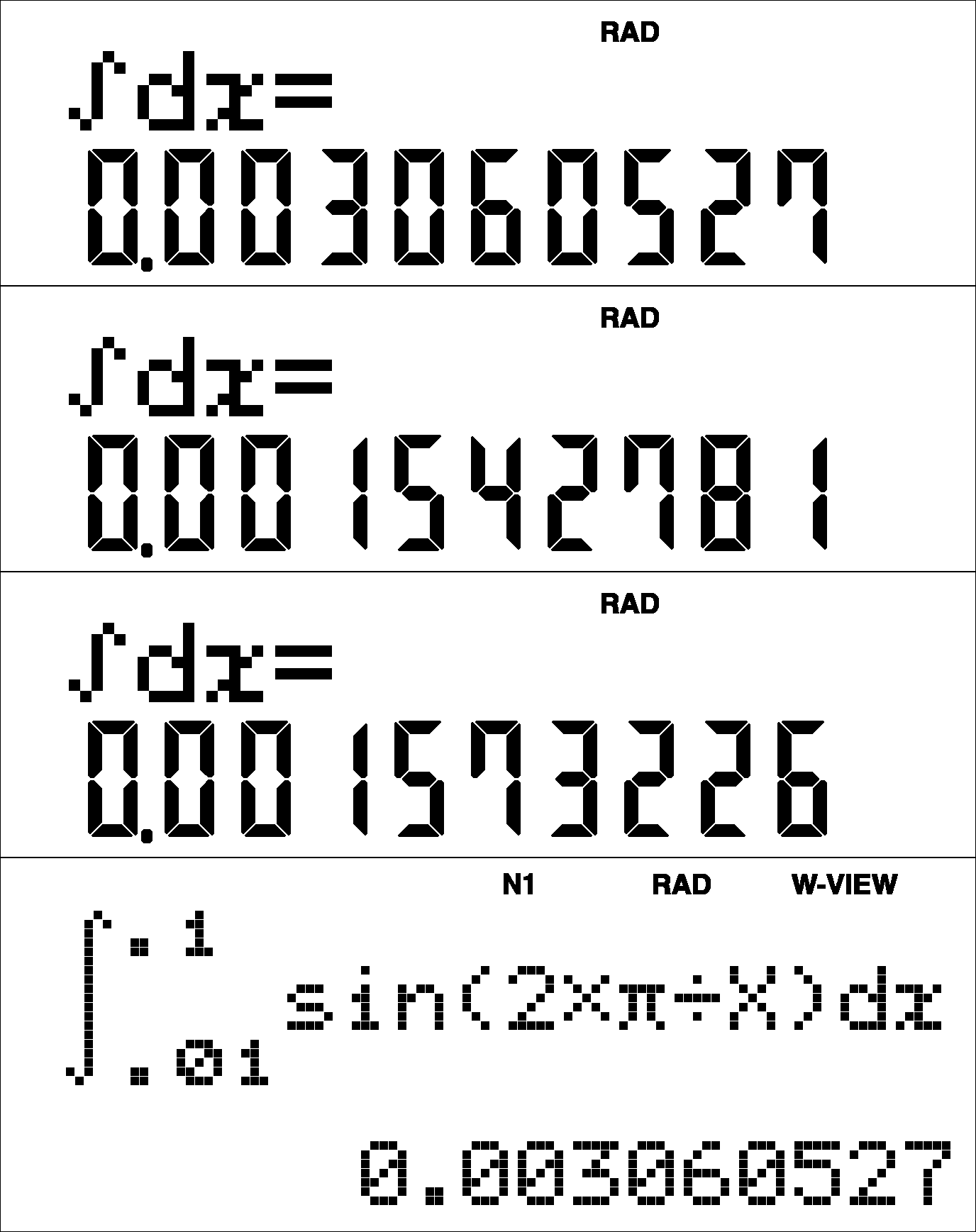
The only advantage of SHARP is that they offer free emulators for some of their models (an older list, a newer one, but the emulators are the same), whereas CASIO and TI only have commercial, ridiculously expensive subscription-based simulation apps for Windows, with a trial period. And SHARP’s emulators (called by them “simulators”) seem to match even the slowness of the physical calculators!
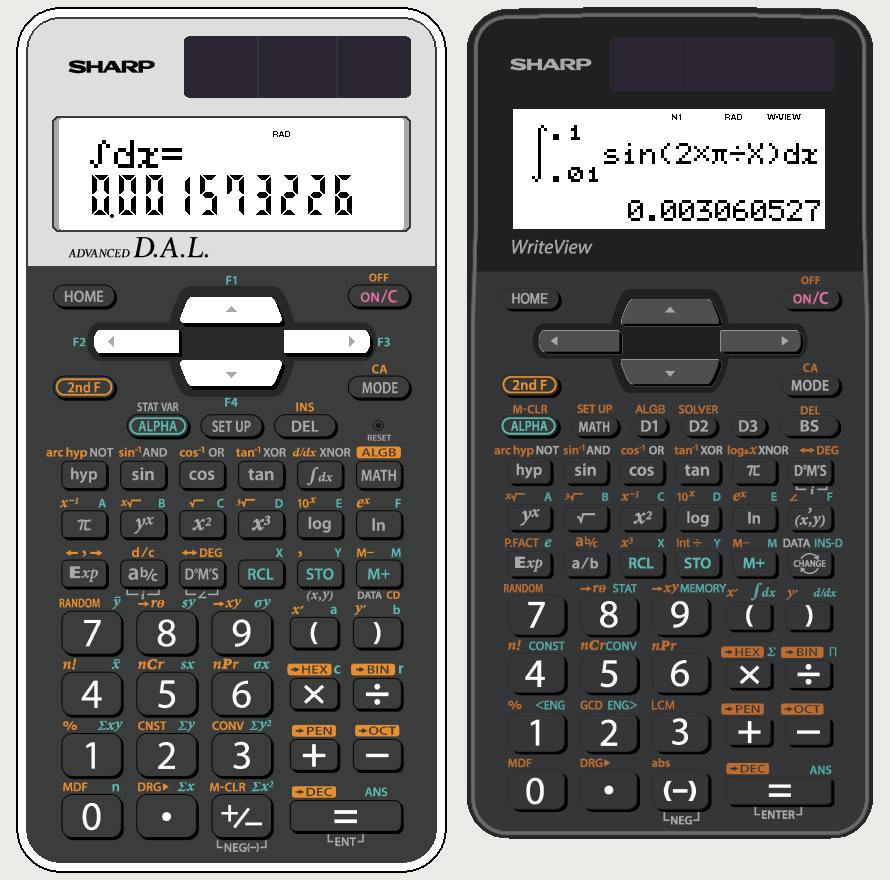
Here’s how I see it:
- The WriteView models that support numeric integral calculus (there are only two of them out of nine currently in production: EL-W506X, EL-W506T) have added the integral calculus à contre coeur, reluctantly, as they care much more about statistical functions than about integrals (the two functions are tertiary functions, invoked using ALPHA and the round brackets). As a result, they just didn’t care about the precision, and decided that cutting the integration interval in 100 is just fine.
- The 2-line D.A.L. models that support numeric integral calculus (EL-520TS, EL-520X, EL-506TS, EL-506X) tried to seem to have taken the job almost seriously, so they reserved a button to integral and derivative, and they left to the user the option to choose between accuracy and speed. Even so, the accuracy is pathetic (what integration approximation method are they using?!). Atop of that, they screwed their “Advanced D.A.L.”: whereas in the WriteView models everything is entered strictly infix with final evaluation (à la V.P.A.M.), the D.A.L. models require everything to be entered before pressing the integration button, so integration is a postfix operation here! (Not before a final ‘=’ though, as three parameters have to be specified). Crazy, annoying, and confusing.
- The only correct (?!) approach seems to be used by SHARP in the graphical EL-9950, where an optional precision can be specified, and the default value is 1E–5.
Well, at least SHARP can do simple integrals correctly:
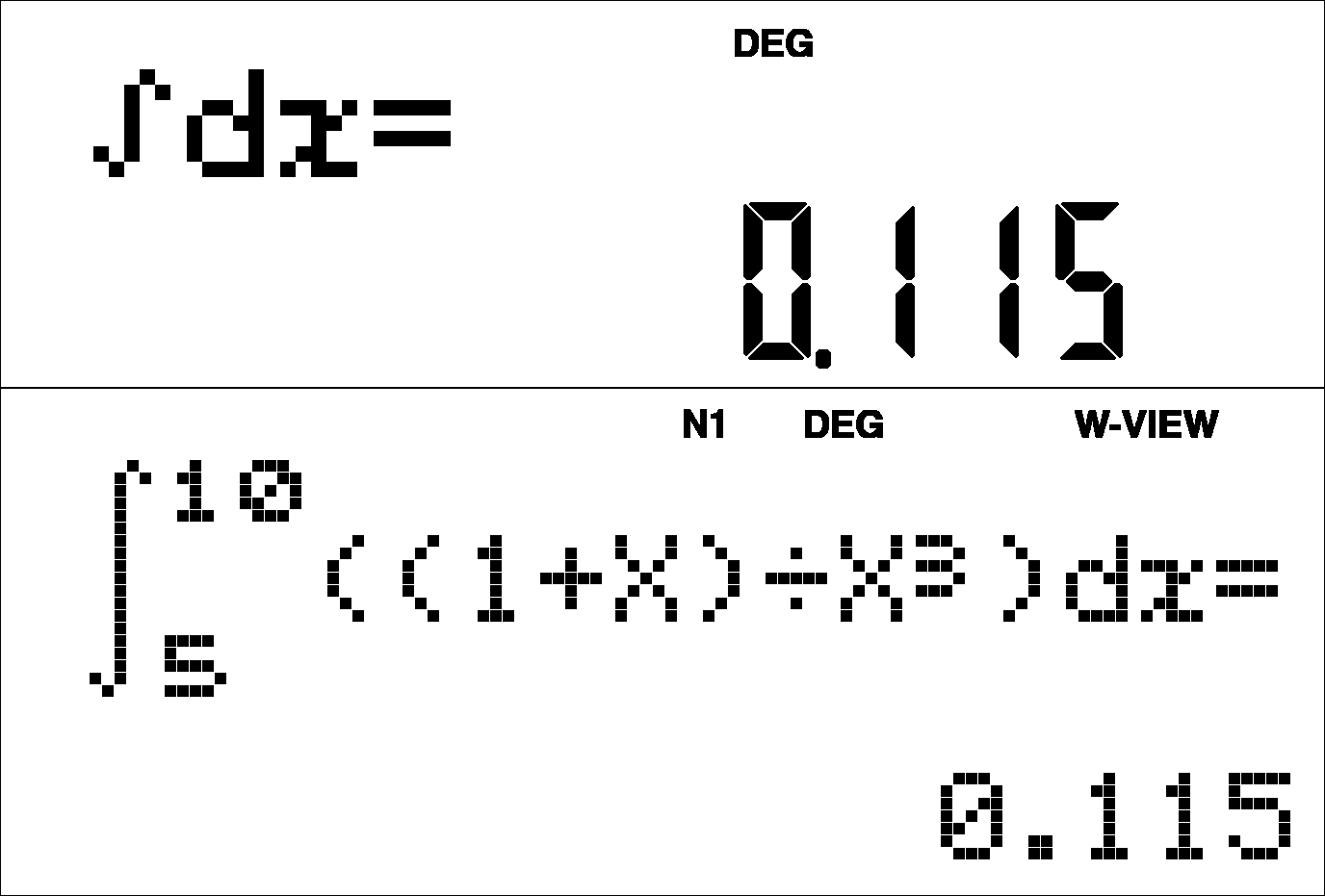
Somehow, I wasn’t able to convert the result directly into the fraction 23/200 (the button didn’t do anything!). Another bug related to the integration operation? TI-30X Pro can convert right away the result to a fraction.
But here’s a bug on the TI-30X Pro (the 2nd Gen.): if SHARP EL-W506T could automatically use fractions in the case of another integral that wasn’t using trigonometry…
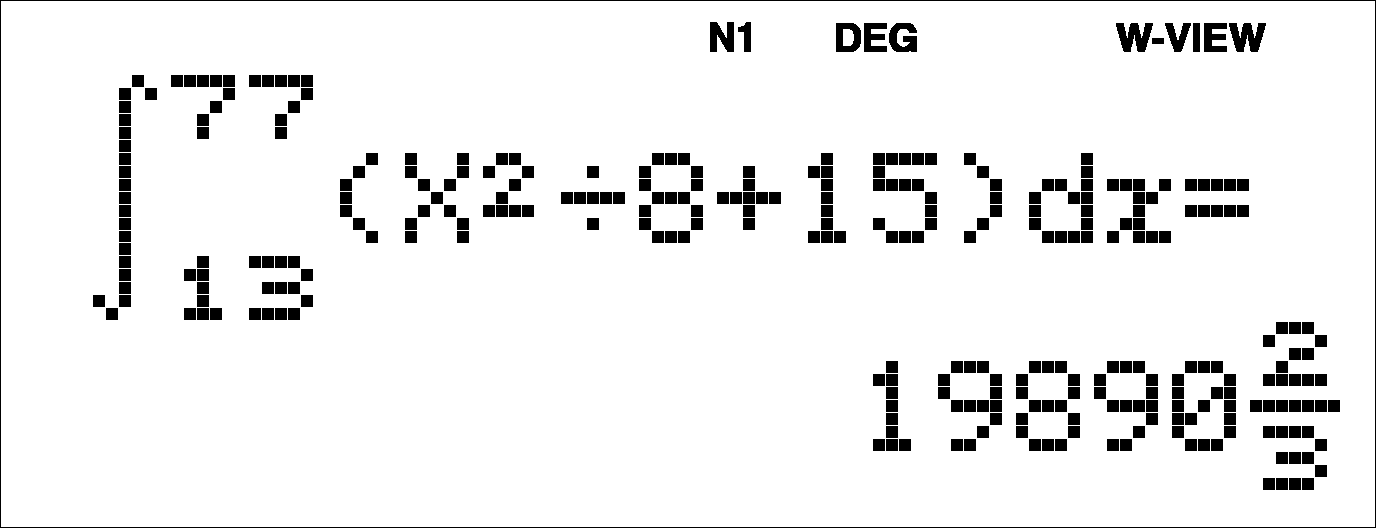
…the TI-30X Pro (the 2nd Gen., meaning it’s labeled MathPrint, not MultiView) gives the result as follows:
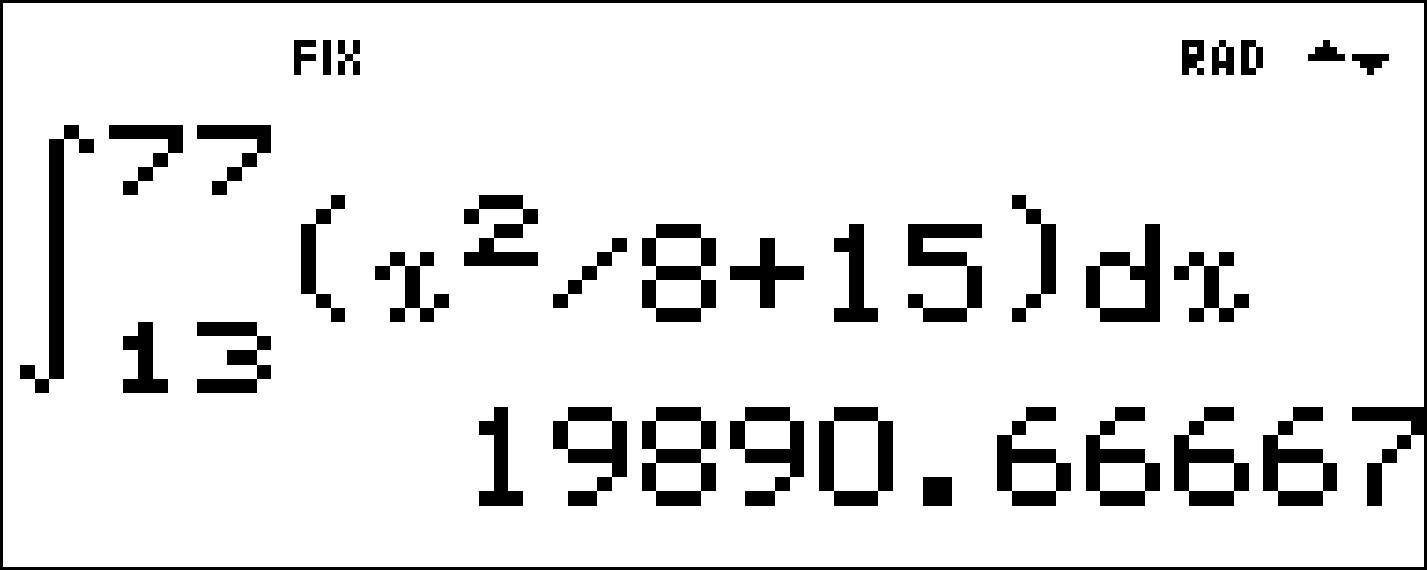
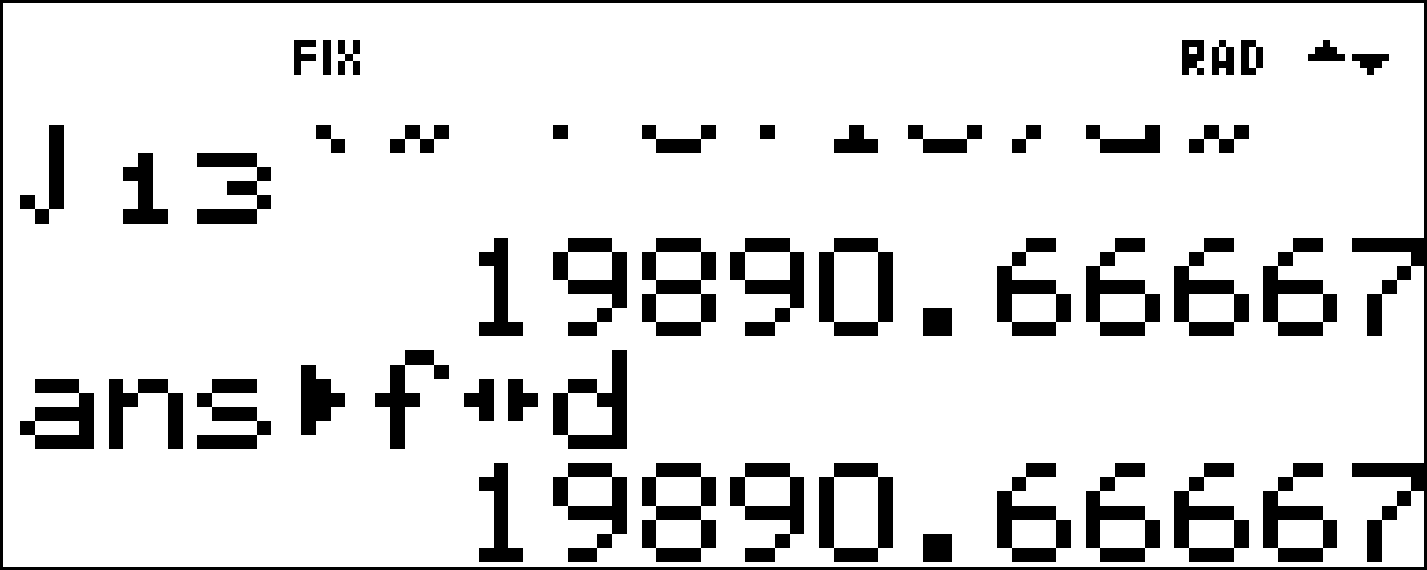
Nonetheless, by adding 1/3 as a fraction, it acknowledges that the result is an integer (but, as TI does, it still displays the useless trailing zeroes):
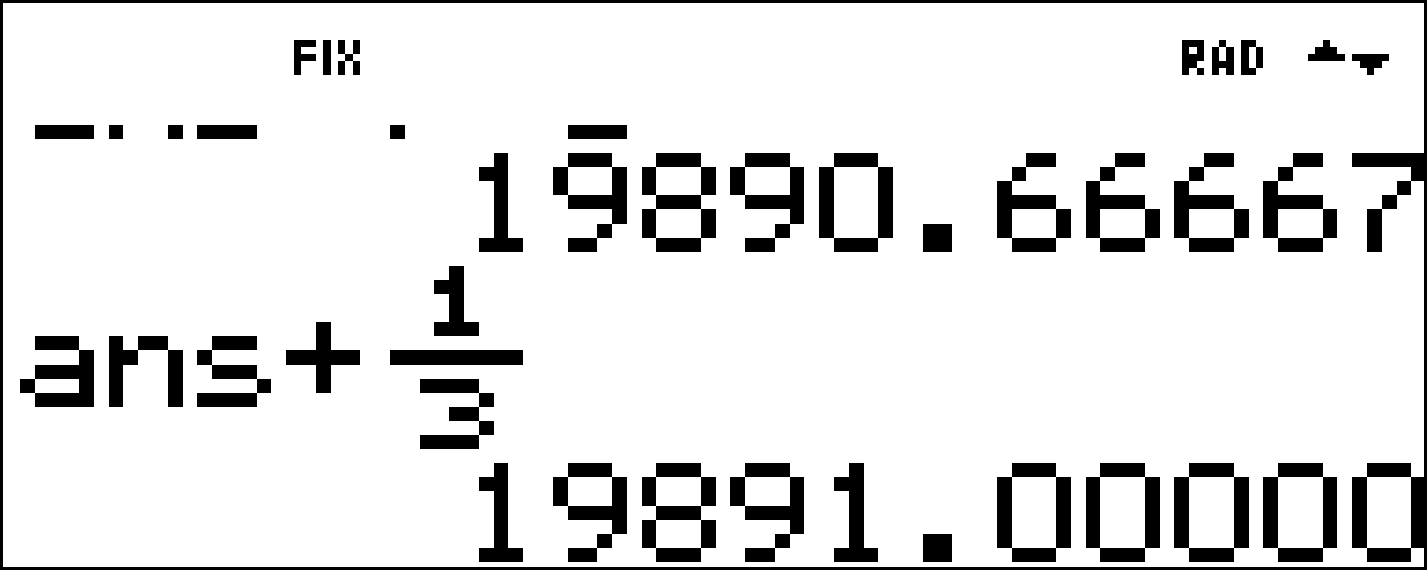
Well, a TI device without a bug wouldn’t be a TI device! Maybe, after all, SHARP EL-W506T has a potential…
…but the simplest scientific SHARP, EL-501X, doesn’t! Here’s a review for EL-501X2 (I don’t know what makes the X2 different from X, but it seems that the X2 is for the US market):
When it arrived, I started using it immediately. I frequently use exponential functions and logarithms (these operations are very common in chemical equilibria and kinetics) and noticed that some results were not right. It seems that the EL501X2 cannot handle exponential function with negative arguments when the argument was obtained by some operation. 🙁
To illustrate, with each keystroke in square brackets [] and comments in parentheses ():
[1] [+/-] (display shows: -1) [2nd F] [e^x] (display shows: 0.3678…, which is correct)
Now try [0] [-] [1] [=] (display shows: -1) [2nd F] [e^x] (display shows: 2.718…, which is WRONG! It is e^+1 instead of e^-1)
In other words, if you enter a negative number, e.g. -1, and use it is an argument for the exponential function, it’s OK. But if you obtain a negative number as a result of an operation, e.g. 0-1=-1, and use it as an argument for the exponential function, the negative sign will be ignored. 🙁
And one more: [0] [-] [1] [=] (display shows: -1) [+/-] (display shows: 1) [2nd F] [e^x] (display shows: 0.3678…, so now the calculator thinks we had -1 instead of +1 and calculated e^-1 instead of e^+1) 🙁
Why would this guy purchase the cheapest scientific calculator from SHARP, beats me. But the choice was obviously a bad one.

But that was one of the many reasons for Gareth Greenwood to consider that the Japanese calculators are pure shit. Let’s now add something from my grimoire.
A couple of years ago, I noticed this thing: These two Casio calculators showing different answers for the same input:

It was after the recurrent idiocy of “this math equation divides the Internet” (in which only the arithmetic expression changes, but the stupidity remains).
I explained the situation in my old post on calculators (under “UPDATE 1”) as a problem with implied multiplication (or should I say implied lack of knowledge of the operator precedence and of the correct order of operations?).
The explanation for the above situation can be found in the user’s guide for each device:
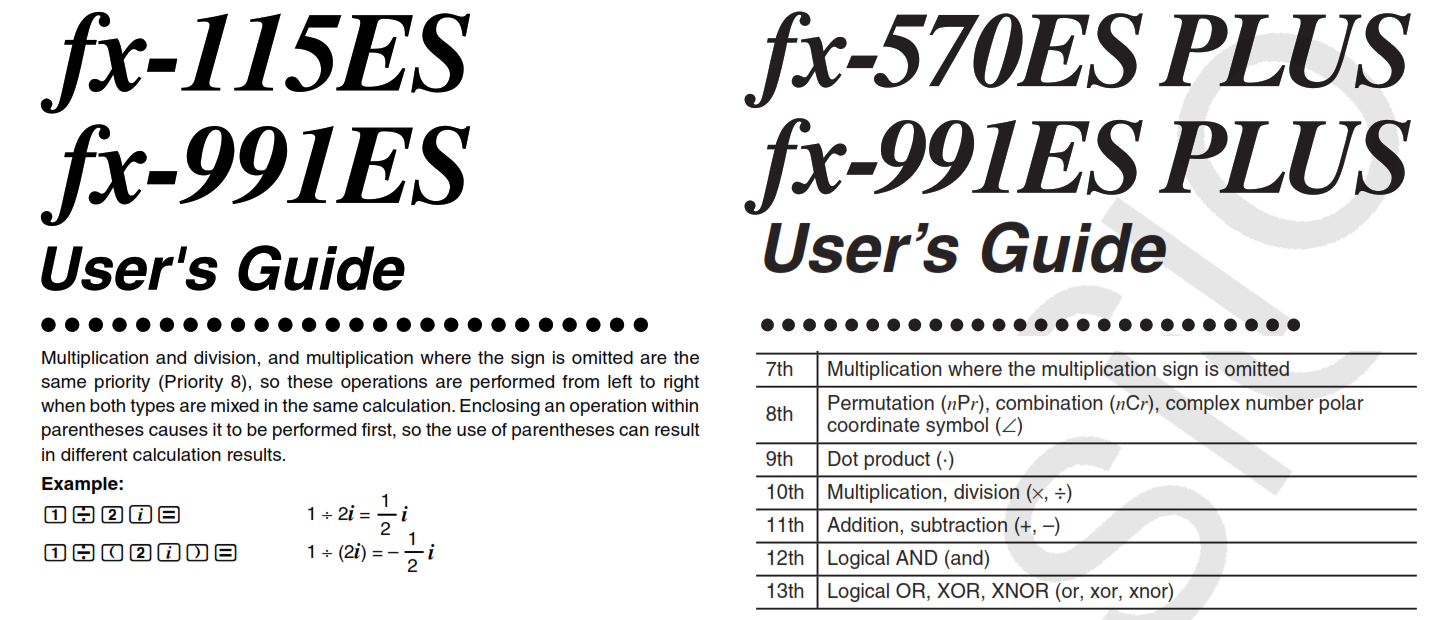
To quote myself:
The first device, fx-991ES, uses the correct order of the operations (which, BTW, is PEMDAS), performing a strict left-to-right interpretation of the explicit and implicit multiplication and division operators. The second one, fx-991ES PLUS, chose by design to give a higher priority to the implied multiplication (“multiplication where the multiplication sign is omitted”). I can understand that some people might consider that omitting the multiplication sign somewhat “creates a tighter bond” between the operands, but there is no rule to state that. I can only think of CASIO as of a company that gave way to the idiots when designing newer devices.
See another example of generalized public stupidity in another post of mine, What divides the Internet is not math.
Let me now try two examples as a “litmus test of the knowledge of the operator precedence and of the correct order of operations”.
SHARP EL-506TS and EL-W506T fail the test!
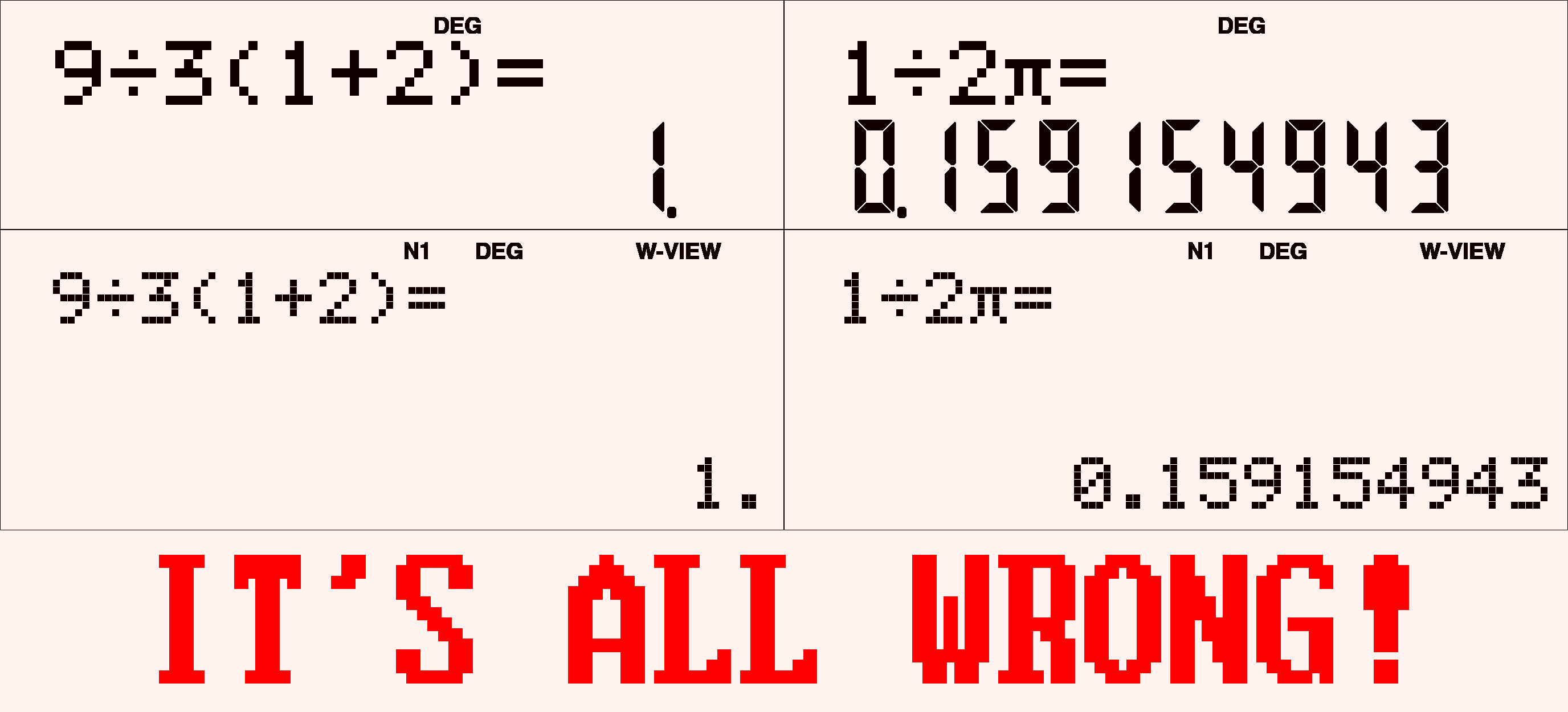
CASIO’s fx-570EX_991EX Emulator fails the test!
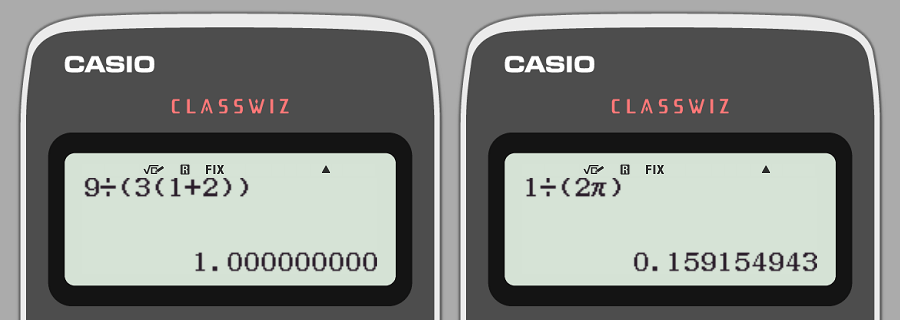
TI-30X Pro is (how else?) … CORRECT! (That’s the emulator, but I first tried on the physical device.)

Most physical calculators fail the test, to be honest. They’re designed for retards. Most Android apps fail the test too, but some are bravely knowledgeable and thus correct:

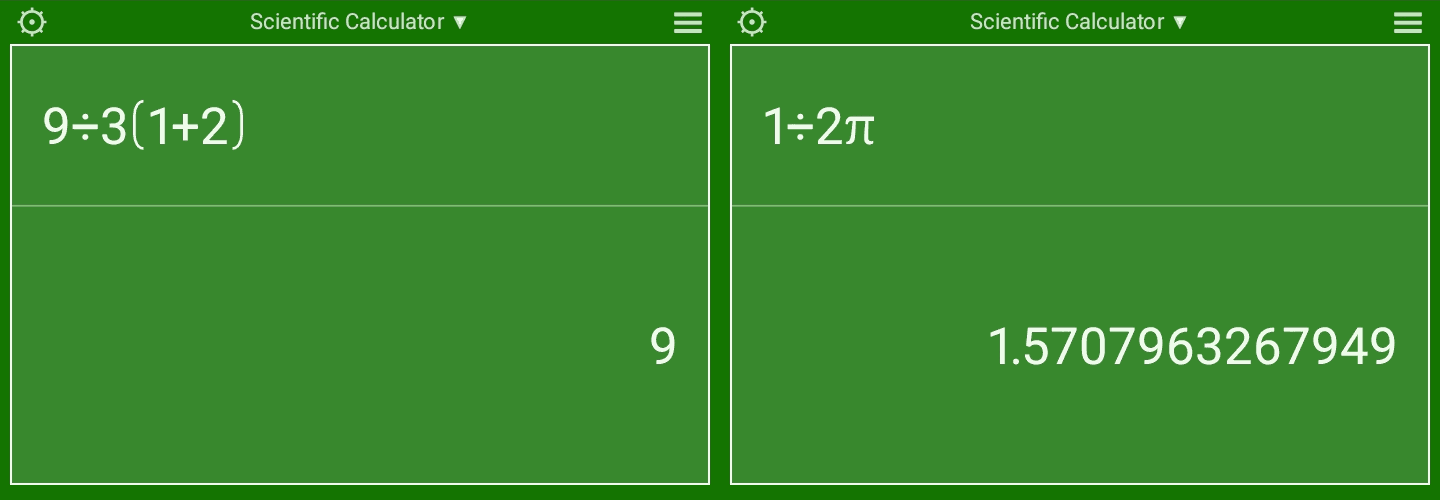
In the last one, by Philip Stephens, the “implied multiplication” toggle must be set on “don’t imply shit” (the left variant):

In real life, I always add the operands, and when I suspect I risk encountering stupidity, I add parentheses to avoid mishaps, but I guess we can agree with Gareth: screw the Japanese junk, go for TI!

What’s left to be said?
One thing I’d have liked to find in the list of Gareth Greenwood’s interests was something around Raspberry Pi, or similar fruits and SBCs, or even microcontroller boards such as Arduino and Raspberry Pi Pico. It wasn’t there. Maybe that’s because he’s a purely IT guy, without a background in electrical engineering?
Well, either way, for that one I can watch Christopher Barnatt, which is another smart guy, just differently.

SHARP EL-506TS: 0.003060527 (in 100 points = the default)
SHARP EL-506TS: 0.001542781 (when using 1,000 points)
SHARP EL-506TS: 0.001573226 (when using 10,000 points)
Raspunsul e simplu – au folosit degete diferite cand au introdus datele!
Lasand gluma – te mai mira ca pica avionul cand calculele au fost facute “corect” cu calculatorul?
Nay, people use Excel nowadays. And PowerPoint.
Bonus puzzle involving numbers and a calculator, from The Sunday Times (Teaser 3031 from Sunday October 25 2020, also in “The Sunday Times Teasers Book 1” (ISBN-13 978-0008472788):
No, I don’t know the answer.